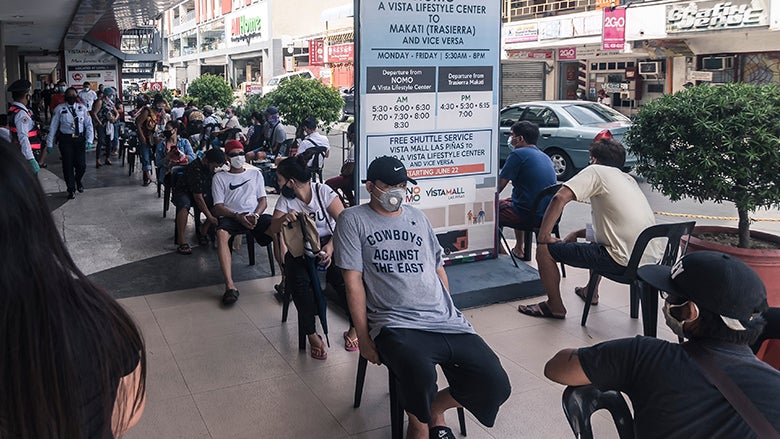 Manila, Philippines - August 2020: People line up at a remittance center to receive SAP aid from government. (Photo by: Michael D Edwards / Shutterstock.com)
Manila, Philippines - August 2020: People line up at a remittance center to receive SAP aid from government. (Photo by: Michael D Edwards / Shutterstock.com)
Manuel, a 43-year-old cook at a local restaurant in San Jose, Rizal, Philippines who lost his job during the COVID-19 lockdown in March, had been waiting for 9 hours in an endless line outside his barangay hall (community center). The harrowing thought of contracting the virus from the crowd briefly occurred to him, but for the prospect of receiving 5,000 to 8,000 pesos (approximately US$100-$160) from the government’s social assistance program, it seemed worth the trouble.
In fact, Manuel was more worried that his written information on the paper form may become smudged and illegible due to sweat. He did not know how to prove that his household really needed cash assistance when everyone else in the queue looked equally desperate. Just in case, he brought his voter ID card, PhilHealth card, and even a receipt from his municipal health center, to ensure he did not miss any of the required documents.
The Philippines’ early social protection response to the socio-economic consequences of COVID-19, as illustrated in Manuel’s story that we learned from a recent survey, reveals a sobering discrepancy between the government’s aspiration and implementation challenges. The government announced a large-scale Social Amelioration Program (SAP) – one of the world’s largest cash transfers in terms of the proportion of the population covered – to compensate for workers’ income losses due to strict community lockdowns. The SAP was hailed for its scale and timeliness until challenges in execution revealed the shortcomings of the delivery systems for effective and efficient implementation.
Countries that already had the digital tools for social protection delivery in place – the transformational trilogy of digital foundational IDs, digital payment systems, and interoperable databases in the public sector – before the pandemic was able to implement COVID-19 emergency cash transfers more efficiently. While large numbers of people may claim their needs for government subsidies, a dynamic and up-to-date social registry cross-checked with administrative data can help governments make data-driven decisions on how to prioritize and whom to support first.
Digital foundational ID systems to verify the unique identity of applicants ensure that payments reach the right beneficiaries with reduced risk of fraud and duplication. Some countries such as Singapore and Thailand allowed citizens to apply and verify themselves online using their digital IDs. This worked well for beneficiaries with digital access and, at the same time, freed up scarce human resources to facilitate manual applications for those without. Finally, when beneficiaries have a bank or mobile money account that is verifiable, secure, and safe, payments can be just a click away.
The Philippines has maintained solid social protection programs and delivery systems, especially through the country’s flagship Pantawid Pamilyang Pilipino Program (4Ps) for conditional cash transfers. However, upgrades to the delivery systems triggered by the urgent need to respond to the COVID-19 pandemic have fallen short.
In an effort to leapfrog to digital delivery of social protection, the Philippines’ government, led by the Department of Social Welfare and Development (DSWD) in collaboration with the World Bank, prepared the Beneficiary FIRST Social Protection Project. Approved on September 28, 2020, as one of the World Bank’s COVID-19 emergency operations, the project pursues a beneficiary-centered approach through Fast, Innovative, and Responsive Service Transformation (FIRST).
A bedrock of Beneficiary FIRST is to harness international best practices and the progress government is making as part of its digital transformation agenda to put in place the ‘transformational trilogy’ for social protection delivery in the Philippines.
- First, the project helps DSWD leverage PhilSys, the Philippines’ digital foundational ID system. The PhilSys, for which registration launched in October 2020, will enable the government to uniquely identify and verify beneficiaries. In the future, Filipinos like Manuel will be able to do most transactions such as opening a bank account or applying for an emergency subsidy, with just their PhilSys Number (PSN).
- Second, the project aims to support digital government-to-persons (G2P) payments and, in doing so, accelerate financial inclusion. Having access to bank accounts or mobile wallets is an important first step for digital payments. By providing information and promoting financial literacy among beneficiaries, the project can also help beneficiaries use the accounts for savings, purchases, and financial transactions, creating a credit history that could unlock new economic opportunities.
- Finally, the project enables DSWD to build on the PhilSys and up-to-date Listahanan – the National Household Targeting System – to develop a robust data management framework and unified beneficiary database. Apart from addressing the existing fragmentation of data between programs, having master data and standards in place will help the government make smarter use of data and better prioritize resources for the needier populations.
Although the COVID-19 pandemic has brought numerous challenges for social protection delivery in the Philippines, there is room for optimism. Government commitment, resources, and plans are in place to put lessons learned into practice. Realizing the "transformational trilogy" of digital ID, digital payments, and digital data management for social protection in the Philippines will help people like Manuel better cope with economic hardships during and beyond the pandemic.
Note: Names in this story have been changed to protect the privacy of individuals.


Join the Conversation